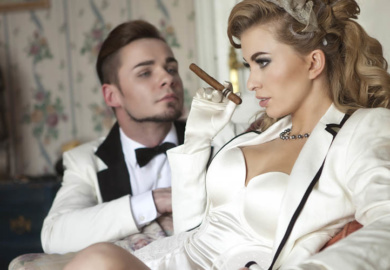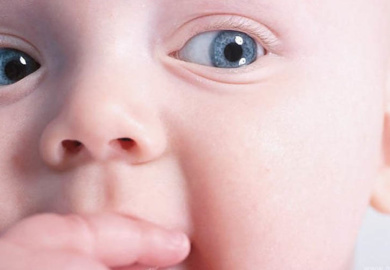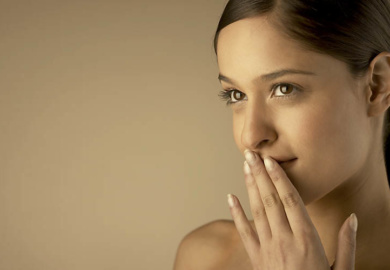Ten Body Language Secrets
We call them secrets because so few people seem to appreciate how important they are to body language. Each of the ten “secrets” listed below deserves a whole section but hopefully this page will provide a basic introduction.
MIRRORING
This is the technique of consciously using your body language to mirror the subconscious movements and gestures of others – in a way that is subtle and unnoticed at their conscious level. This body language can include gestures, vocal tones, breathing rate, posture, attentiveness and even facial-expressions. It is important that you do not “copy cat” their motions as this will quickly become noticeable. The trick is to use similar body language postures or gestures approximately ten seconds after they have. It is harder to do than it sounds and requires practice to appear casual and natural. Mirroring is an important secret because it occurs naturally when people are building a positive rapport and by deliberately doing it you can send an encouraging message that strengthens the developing relationship.
According to NLP (Neuro-Linguistic Programming) experts, this technique will build trust and liking in the person with whom you are communicating. You can apparently measure the success of your mirroring if, after a while, you introduce gestures that the other person hasn’t used and then they start to subconsciously copy you. It is at this point you can express your own desires and intentions with the greatest likelihood of the other person being agreeable. Both conscious and subconscious mirroring is most often seen in romantic and business situations where the relationship that is being established is fundamental to the success of the endeavour.
(Aquiziam footnote: We decided to test this technique to see if it really worked. We used it in several social situations and deliberately mirrored the actions of people we had just met. In all cases the communication flowed easily and a positive rapport was established. In an equal number of instances we deliberately, but with subtlety, tried to use posture and gestures that were the opposite of those that our test subjects had just used. In all cases the communication was uncomfortable and in four out of five cases the person with whom we were communicating left as soon as they could do so. We realise that our own autosuggestion may have influenced the outcome of the test but it was interesting and seemed to indicate that mirroring does have a definite effect.)
BODY FORM
The shape and condition of your body sends a message whether you want it to or not. It has become so socially and politically “incorrect” to comment or judge people based on their body form that this aspect of non-verbal communication is often ignored in explanations and teaching – but not in reality.
The secret is this: Humans do consciously and subconsciously judge others in this way. Pretending that they don’t won’t make it go away. If you see a very fat person then it is often (but not always) fair to assume that the person probably eats too much and exercises too little. Sometimes these people are very adept at deceiving themselves and others. At some time we’ve all probably heard someone say, “I eat like a bird but the pounds just pile on!” Actually, the truth is that in most cases they do eat like birds – like vultures. What they actually mean is, “I eat like a little bird when other people are watching but on my own I’m happy to eat six pizzas and a whole cake just for lunch.”
Doctors will often admit that they would rather trust what they see in a physical examination rather than what patients tell them. Someone who has well formed muscles and a fit physique probably has self-discipline. Someone who has broad shoulders and a narrow waist is likely to be more confident. Fat people are often physically lazy. Taller people are less likely to exhibit frustration. Of course there are also a lot of myths. There is no evidence that redheads are likely to be more temperamental or that men with heavy eyebrows are untrustworthy. Even so, we still judge people by the way they look. Sometimes the messages change over time. It is true that being overweight did once represent success and wealth when food was scarce and expensive. It is also true that many high-level (successful) company executives do still tend to be overweight. (It’s these damned business lunches!) However, fit and trim is now becoming a greater symbol of success.
PERSONAL BODY LANGUAGE / MOOD TELLS
Some body language is very specific to an individual rather than a group or society. It’s trait that people develop as a response to how they are feeling that has little resemblance to general behaviour. For example; most people are likely to touch their lips or nose when they tell a lie. In the case of a particular boy he would always push his right hand into his back pocket. (Perhaps to stop himself from touching his face?) Once you work out what the body movement means it can become very useful when reading that specific person’s body language. These are often called “Personal Tells”. Almost everyone has them and in most cases we are completely ignorant of their existence as they apply to us personally.
A certain company Chief Executive would always start scratching the tip of his nose if he was irritated by what people were telling him.
A particular woman we know always starts making little sniffing noises if she doesn’t like the food she’s been served in a restaurant.
Perhaps the most unusual example was the case of girl we knew at university. Her boyfriend noticed that whenever she became sexually aroused she would start stroking her left earlobe with the thumb and forefinger of her left hand. Apparently she once said to him: “It’s amazing how you always know when I’m feeling turned-on.” In poker, professionals often study the other players to see if they have personal body language that can be used to “tell” whether they’re holding good or bad cards.
ENVIRONMENT AND BODY LANGUAGE
Environment has a measurable impact on body language and the way that it is displayed and observed. Dilated pupils are often associated with arousal. However, pupils also dilate when it is dark. It is for this reason that candlelight has become associated with romance. In a study of theatre audiences it was found that actors performed better if the theatre seating was comfortable for the audience. The reason for this was that if the seating was uncomfortable the audience tended to fidget and sit awkwardly. Some even sat in a hostile way with their arms folded. The stage actors could see this negative body language and it impacted on their confidence. Even though the negative body language was irritation with the seating it still had an influence on the rest of the audience and the actors even though it wasn’t aimed at them.
The fact is that people react to their environments by displaying responsive body language. People cross their arms when they are defensive but they also cross them when they are cold. The landlords of pubs and bars know that their guests like to feel comfortable when they go out for a drink. They don’t want to see everyone standing around with their arms crossed. For this reason owners make sure that their bars are “warm and inviting”.
FACE MAPS
Whenever we smile, frown or use some other facial expression the skin on our face moves and compresses into lines (creases). In young people the high elasticity of the skin means that the when the expression changes the lines disappear. However as people get older, and the skin becomes less elastic, wrinkles form and very often these wrinkles are indicators of the facial expressions that a person has used most often. Therefore a woman with vertical mouth creases is likely to have spent a great deal of her life pursing her lips – an expression usually associated with disapproval. A Man with deep wrinkles in his forehead caused by frowning may have spent much of his life worrying. There are literally dozens of wrinkles that can be interpreted by the competent face map reader.
The much guarded secret of fortune tellers is that they can often predict your future – not by looking into a crystal ball – but by looking at the wrinkles on your face. These lines can tell a great deal about your personality and state-of-mind. Thus a person with very distinctive laughter lines around the eyes could be told: “you’ve been happy most of your life and will continue to be.” Reading the lines on a person’s face is difficult as it takes a lot of practice and there is very little written reference material on this subject. We will provide some detailed pages when we’ve done enough research. Still, some of the basics are just commonsense. See the pictures above.
BRAND LANGUAGE
Big business has spent literally billions of dollars over the past decades to convince people to buy their products. In many cases they do this by creating brands with which people want to be associated. These brands are said to have values. For a long time Coca-Cola presented its values as “fun and family” while at the same time “Pepsi” was presenting its values as “daring and exciting”. Although people claimed that they chose their preferred cola drink based on flavour, most people were buying based on habit or brand value. The result: American kids bought Pepsi but American moms bought Coca-Cola.
Almost all major high-street brands have values and our choice about which products we buy can be used to better understand our personalities. People who buy Jimmy Choo shoes do so because they are good shoes … but they also choose them over other brands of good shoes because by wearing them they can make a personal statement to others that understand the “shoe fashion code”. The same is true of watches, jewellery, vacuum cleaners, cigarettes, clothes, handbags, pens and very definitely cars. For example; station wagons (estates) are believed to be chosen by practical people – sports cars by the adventurous. There’s a very detailed pseudo-science to this but at a day-to-day level we all make conscious and subconscious decisions about people based on this buying behaviour (and subsequent display of brands) as a source of information input.
THE MAGIC OF CLONING
Looking like someone famous can have its advantages and at the very least it ensures that you are noticed. When Joanna Lumley played the part of Purdey in the hit 1970’s TV series “The New Avengers” she had a distinctive hairstyle that people of the time had not seen before. It was quickly dubbed the “Purdey Bob” and within weeks’ women all over Britain were having their hair cut in the same style. Princess Diana also had a distinctive hair style that the public loved and it too was a “hit” with women. The truth is that looking like someone famous seems to pass-on some of their celebrity status. It also means that people seem to attribute some of the “talents” that the star might have – either as a character or as a person – to the look-a-like.
In the context of body language it is possible to be perceived in a certain way by resembling a famous character. Over the years many thousands of men have tried to copy the distinctive and sexy Scottish accent of Sean Connery and women have desperately died their hair blonde and straightened it to look like Jenifer Aniston. In fact, at one time – around about 2004 – a man could go to a Manhattan nightclub on any night of the week and be forgiven for thinking that the world had been taken over by aliens who were rapidly turning every female on the planet into a clone of Ms. Aniston.
Here’s the secret … If you wish to be perceived in a certain way then choose a famous personality with the characteristics you desire and find a way to look like them. Try and be realistic. If they’re tall and blond and you’re short and dark you need to find another person to clone. It’s weird and it seems a bit magical but it works. (Try and avoid plastic surgery!)
SELECTIVE STEREOTYPES
There are two parts to this – what to do and what to watch out for. Selective Stereotyping is the typical way most humans react to people that simply look-the-part. For example, you see a man in a white laboratory coat wearing glasses with a stethoscope tucked into his pocket. You automatically think he’s a doctor – somebody you can trust. But what if he isn’t? We tested this aspect of body language.
In November of 2008 one of the team borrowed a white coat and stethoscope and bought a pair of cheap prescription glasses. He then walked into a major public hospital holding a briefcase in one hand and a clipboard of papers in another. No one stopped him. The security guard even smiled and said, “Good evening sir.” Nobody even glanced at his ID card that was clipped to the jacket. If they had they would have discovered that the man was a member of a well known gym. They didn’t check because he looked the part.
Stereotypes are powerful! Firemen, police officers, security guards, doctors, soldiers, corporate executives, teachers, scientists, pilots, nurses, desperate housewives, prostitutes and street bums are just a few examples of people that have stereotypical appearances. Most people will react to you based on the way you appear. The same guy that played the doctor later dressed up like a bum and tried to get into a popular restaurant in London. Naturally, they turned him away. It was the same guy but just a different stereotype.
As humans it is natural for us to believe in the stereotype even though it is clear that this is just the effect of cultural training. Here is a warning. A white coat doesn’t always mean doctor. A short skirt and torn stockings doesn’t always mean prostitute. Here’s the secret: People will react to you based on the stereotype that you present. If you want to be perceived in a certain way then be prepared to play the part. In reality, everyone is an actor to some degree.
BODY SIGNS
Bags under your eyes, purple nails, moles, hair condition, skin colour, baldness, dermatitis, acne, favouring, and skin tone are all body signs. These things are the signs that tell doctors, and everybody else, about our general physical condition.
The secret is that this is body language at its most basic and, as such, often overlooked. All of these “indicators” are telling other people about us. A pallid skin colour may mean too much time indoors. (Writing for Aquiziam) Purple toes or finger nails may indicate poor circulation. Favouring one leg over the other or limping may indicate bone disease or injury. Bags under the eyes may mean lack of sleep. Gout may well indicate excessive alcohol consumption. Our bodies are advertisements to our lifestyles and our health. At a conscious and subconscious level they are noted by other people. It is therefore human nature to try and hide them. Makeup hides acne, Botox hides skin aging and cucumber pads will even temporarily shrink bags under the eyes. It is important not to jump to conclusions but it is equally important to pay attention to yourself and others.
It is possible to learn a great deal about a person by simply observing the signs in an objective way. Here is a good example. After years of working in a very stressful environment employees of a senior vice president noticed that whenever he became angry the pupil of one eye would grow large (dilate) and the other would stay small (contracted). Over time he seemed to become increasingly irrational in his decision making. Finally some brave person mentioned the “eye thing” to him and he had it checked out. The doctors found a brain tumour. He’s fine now … thanks to the way that his body advertised that it had a problem. We’ve used medical examples but it applies to many other areas as well. The trick is to look beyond the obvious and what we are used to seeing. With practice it is possible to see what others can’t. (Please note, this is not medical advice. If anything that you have read (or seen) has caused you concern then please consult a fully qualified medical practitioner.)
CONTAGIOUS BODY LANGUAGE / MOB LANGUAGE
Studies done on the “mirroring effect” have clearly shown that people will often subconsciously duplicate the body language of others in a one-to-one interaction. However a similar effect occurs in groups. If you are in a crowd where lots of people are laughing then you are much more likely to laugh too. If you go into a room where people are standing with their arms folded in a hostile way then you may feel defensive and cross your arms as well. The secret is that the more a group displays a certain type of body language the more likely it is that they will reinforce each other’s perceptions and physical behaviour. This is a critical component of communication with very practical applications. For example: If you wish to enjoy an evening of romance you are more likely to be successful in a place where other people are also displaying courtship behaviour. This is because their body language is contagious. To see the proof of this just visualise sports matches, parties, riots, nightclubs and protest marches. The most obvious example is clapping – one person starts it and then suddenly you’re clapping too. The more people that clap the more likely it is that you will join in.







